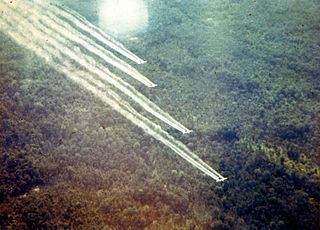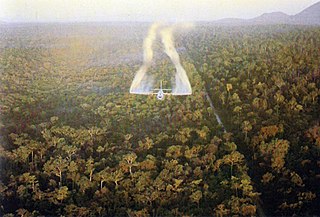Related Research Articles

Agent Orange is a chemical herbicide and defoliant, one of the tactical use Rainbow Herbicides. It was used by the U.S. military as part of its herbicidal warfare program, Operation Ranch Hand, during the Vietnam War from 1961 to 1971. The U.S. was strongly influenced by the British who used Agent Orange during the Malayan Emergency. It is a mixture of equal parts of two herbicides, 2,4,5-T and 2,4-D. In addition to its damaging environmental effects, traces of dioxin found in the mixture have caused major health problems and deformities for many individuals who were exposed, and their children.

Johnston Atoll is an unincorporated territory of the United States, under the jurisdiction of the United States Air Force (USAF). The island is closed to public entry, and limited access for management needs is only granted by letter of authorization from the USAF. A special use permit is also required from the United States Fish and Wildlife Service (USFWS) to access the island by boat or enter the waters surrounding the island, which are designated as a National Wildlife Refuge and part of the Pacific Remote Islands Marine National Monument. The Johnston Atoll National Wildlife Refuge extends from the shore out to 12 nautical miles, continuing as part of the National Wildlife Refuge System out to 200 nautical miles. The Pacific Remote Islands Marine National Monument extends from the shore out to 200 nautical miles.

Chemical warfare (CW) involves using the toxic properties of chemical substances as weapons. This type of warfare is distinct from nuclear warfare, biological warfare and radiological warfare, which together make up CBRN, the military acronym for chemical, biological, radiological, and nuclear, all of which are considered "weapons of mass destruction" (WMDs), a term that contrasts with conventional weapons.

Operation Ranch Hand was a U.S. military operation during the Vietnam War, lasting from 1962 until 1971. Largely inspired by the British use of chemicals 2,4,5-T and 2,4-D during the Malayan Emergency in the 1950s, it was part of the overall herbicidal warfare program during the war called "Operation Trail Dust". Ranch Hand involved spraying an estimated 19 million U.S. gallons (72,000 m3) of defoliants and herbicides over rural areas of South Vietnam in an attempt to deprive the Viet Cong of food and vegetation cover. Areas of Laos and Cambodia were also sprayed to a lesser extent. According to the Vietnamese government, the chemicals caused 400,000 deaths. The United States government has described these figures as "unreliable".

Agent Blue is one of the "rainbow herbicides" that is known for use by the United States during the Vietnam War. It contained a mixture of dimethylarsinic acid and its related salt, sodium cacodylate, and water.

Herbicidal warfare is the use of substances primarily designed to destroy the plant-based ecosystem of an area. Although herbicidal warfare use chemical substances, its main purpose is to disrupt agricultural food production and/or to destroy plants which provide cover or concealment to the enemy, not to asphyxiate or poison humans and/or destroy human-made structures. Herbicidal warfare has been forbidden by the Environmental Modification Convention since 1978, which bans "any technique for changing the composition or structure of the Earth's biota".

Agent White is the code name for a herbicide used by the U.S. military in its herbicidal warfare program during the Vietnam War. The name comes from the regulatory requirements of identifying each container of the various herbicides through the addition of colored stripes. The colors used were orange, purple, pink, blue, and white by the manufacturers to ensure that the contents were easily identifiable during shipment and usage, as the colors were selected by the U.S. government. Largely inspired by the British use of herbicides and defoliants during the Malayan Emergency, it was one of the so-called "rainbow herbicides".

The United States Army Chemical Materials Activity (CMA) is a separate reporting activity of the United States Army Materiel Command (AMC). Its role is to enhance national security by securely storing the remaining U.S. chemical warfare materiel stockpiles, while protecting the work force, the public and the environment to the maximum extent.

Agent Green is the code name for a powerful herbicide and defoliant used by the U.S. military in its herbicidal warfare program during the Vietnam War. The name comes from the green stripe painted on the barrels to identify the contents. Largely inspired by the British use of herbicides and defoliants during the Malayan Emergency, it was one of the so-called "Rainbow Herbicides". Agent Green was only used between 1962 and 1964, during the early "testing" stages of the spraying program.
Operation Red Hat was a United States Department of Defense movement of chemical warfare munitions from Okinawa, Japan to Johnston Atoll in the North Pacific Ocean, which occurred in 1971.

Beginning in the mid-1930s, Japan conducted numerous attempts to acquire and develop weapons of mass destruction. The 1943 Battle of Changde saw Japanese use of both bioweapons and chemical weapons, and the Japanese conducted a serious, though futile, nuclear weapon program.

The Rainbow Herbicides are a group of tactical-use chemical weapons used by the United States military in Southeast Asia during the Vietnam War. Success with Project AGILE field tests in 1961 with herbicides in South Vietnam was inspired by the British use of herbicides and defoliants during the Malayan Emergency in the 1950s, which led to the formal herbicidal program Trail Dust. Herbicidal warfare is the use of substances primarily designed to destroy the plant-based ecosystem of an agricultural food production area and/or to destroy dense foliage which provides the enemy with natural tactical cover.

Johnston Atoll Chemical Agent Disposal System (JACADS) was the U.S. Army's first chemical munitions disposal facility. It was located on Johnston Island, at Johnston Atoll and completed its mission and ceased operation in 2000.

Operation Steel Box, also known as Operation Golden Python, was a 1990 joint U.S.–West German operation which moved over 100,000 U.S. chemical weapons from Germany to Johnston Atoll.
Operation Pacer may refer to one of two different operations involving Agent Orange
Operation Pacer HO was a 1977 operation of the U.S. Air Force that incinerated the Agent Orange stored at Johnston Atoll aboard the Dutch-owned ship M/T Vulcanus in 1977. "HO" was an abbreviation of Herbicide Orange (HO). Operation Pacer IVY (InVentorY) was an associated United States Department of Defense mission to inventory, collect, consolidate, re-drum, remove from the Southeast Asian theater, and store Agent Orange.

The 267th Chemical Company was a military unit of the U.S. Army Chemical Corps responsible for the surety of chemical warfare agents dubbed "RED HAT" deployed to the Islands of Okinawa, Japan and subsequently Johnston Atoll in the Pacific Ocean. A recently discovered Army document reveals that the true mission of the 267th Chemical Company was the operation of the Okinawa deployment site as part Project 112. Project 112 was a 1960s biological warfare field test program that was conducted by the Deseret Test Center. Okinawa is not listed as a test site under Project 112 by the U.S. Department of Defense.
Transpacific may refer to:
The United States chemical weapons program began in 1917 during World War I with the creation of the U.S. Army's Gas Service Section and ended 73 years later in 1990 with the country's practical adoption of the Chemical Weapons Convention. Destruction of stockpiled chemical weapons began in 1986 and was completed on July 7, 2023. The U.S. Army Medical Research Institute of Chemical Defense (USAMRICD), at Aberdeen Proving Ground, Maryland, continues to operate.
References
![]() This article incorporates public domain material from websites or documents of the United States Government .
This article incorporates public domain material from websites or documents of the United States Government .
- ↑ The History, Use, Disposition and Environmental Fate of Agent Orange By Alvin Lee Young, Springer, April 28, 2009, page 123: | ISBN 0387874852 | ISBN 978-0387874852
- 1 2 3 4 "The History of the US Department of Defense Programs for the Testing, Evaluation, and Storage of Tactical Herbicides, December 2006, Submitted by Alvin L. Young, Ph.D." (PDF). Archived from the original (PDF) on 7 October 2012. Retrieved 19 September 2012.
- ↑ Suzanne Marshall PhD: "Chemical Weapons Disposal and Environmental Justice", Kentucky Environmental Foundation, November, 1996 (funded by Educational Foundation of America)
- ↑ "Disposal of Chemical Weapons: Alternative Technologies, June 1992, OTA-BP-O-95 NTIS order #PB92-202180" (PDF). Archived from the original (PDF) on 2 December 2011. Retrieved 8 August 2012.
- ↑ The History, Use, Disposition and Environmental Fate of Agent Orange By Alvin Lee Young, Springer, April 28, 2009 page 130: | ISBN 0387874852 | ISBN 978-0387874852
- ↑ "Phase II Environmental Baseline Survey, Johnston Atoll, Appendix B, page B-20" (PDF). Archived from the original (PDF) on 21 April 2013. Retrieved 20 August 2012.